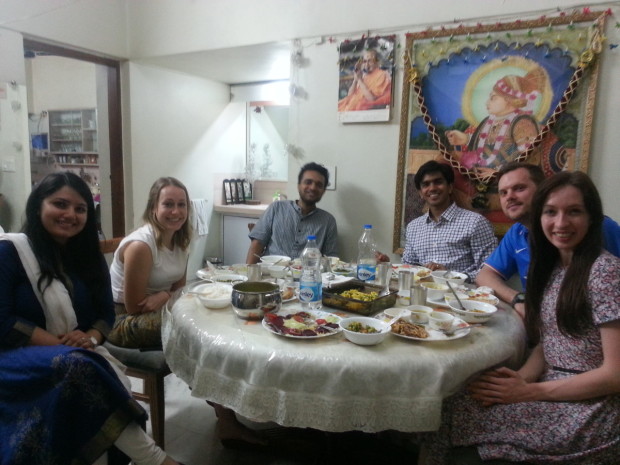AHMEDABAD — We’ve done almost of all of our traveling and reporting in India as a group over the last 10 days. But today was designated a “reporting day,” a time for us to peel off individually or in pairs to research some of the stories that we will write when we return to New York. We all went in different directions, and found considerable truth in this observation by Adelie:
“It’s interesting to see how much you can do and can get done in a city that you don’t know, with so little preparation, finding a story out of the blue, and pulling in an impromptu fixer. India seems like the place where anything is possible.”
Not everything went exactly according to plan, but our reporters made the most of every opportunity. For Sam, the day began in a Hindu workshop on the outskirts of Ahmedabad, where half a dozen men were chiseling away at marble. Chips of the white stone flew under the tick tock, tick tock of large machinery. He was reporting on the production of the murtis, statues that represent deities in Hinduism. Sam brought along his C100 camera, but was barred from taking video. He was told it was for security reasons. Instead, he relied on the most basic of reporting instruments: the paper and pen.
Across the river in the secluded alleyways of the Ahmedabad ghetto, Olivia and Yasmine were perched, microphone in hand, before five Hijras, or Indian transgender people. Donned unsparingly in colorful saris and gold bangles, the Hijras spoke quickly in the foreign Gujarati tongue, slowing to an emotional pause. “What, what? What did they say?” they asked their translator, who forgot to reiterate in the heat of the conversation. Their careful research had given them unprecedented access, save for this unexpected language barrier.
Meanwhile, Nathan was lost. His Uber driver was 20 minutes late to an interview with the state coordinator for the RSS state headquarters in Gujarat. “The directions are something like, ‘this building by this doctor’s office next to this bazaar,’” Nathan later said. He rushed in to report on a story about the divide within right-wing Hindu leaders about how homosexuality fits into Hindutva, a form of Hindu nationalism.
Alice and Jenna were still looking for an interviewer, as they roamed a half abandoned mental health facility in Ahmedabad. With five hours of film and three words of greeting in Gujarati, they leaned on the kindness of locals. “We were confused, we were overwhelmed, and we didn’t know where to go,” Jenna later recounts. “But we gave it time and started talking to people, and the story unfolded.”
Rashmi was back at the hotel researching Jain diets and calling Jain restaurants, while Arielle was sitting over coffee with Bishop Thomas at St. Xavier’s High School. Sara recorded the voice of a 23-year-old liturgical singer, whose song speaks better than the collection of impressive awards on the nearby shelf. At the same time, Rutwij and Nadim strolled the aisles of a local grocery store opened by a Shia Islam priest after the Muslim-Hindu riots in 2002. They probed their subject for a deeper grasp of religion in business.
By now, it was midday. Adelie and Darcy were reporting on their second story, which seemed to have fallen through. They stood in the sweltering heat, before a mosque wall that was not, as their story pitch had postulated, joined to a temple. They would however look elsewhere, returning from the home of an Ethiopian Muslim who belongs to a 500-year-old Sufi community and later, joining a Jewish community to celebrate the one-year birthday of a child, a celebration that included a goat roasting over a coal fire.
Near city boundaries, Gregoire and I kept the audio rolling as we stumbled upon a school in pursuit of a story about the ripple effects of the Hindu caste system in Christianity. Three hundred curious children ambushed us in the courtyard during recess, and as we wondered why a Christian school houses 90 percent of Muslim students, a second story evolved.
By 7 p.m., we came in from the heat and assembled in the lobby of our hotel, the Ahmedabad Ramada. Our day concluded with dinners in the homes of local families. Some dined in a Parsi garden, while others discussed religious customs in a Muslim home. Girls gabbed about diet and local clothing finds in an elegant Jain dining room, while another group debated class politics of the state on the front porch of a two-story Hindu house.

Hosts Anand and Minali Patel invited India Yatra reporters and Professor Trivedi into their house for dinner. Photo by Sam Steinberger.
After seven weeks of studying Indian theological thought, context and history in the classroom, we returned to the hotel in Ahmedabad with something textbooks could not render: a walk in their shoes, a moment in their footsteps. And when we put pen to page or voice to microphone, we more fully realize the empathetic objectivity we aspire for as witnesses and as, well, reporters.